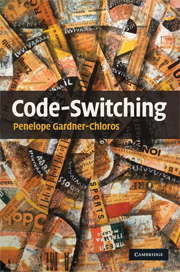Book contents
- Frontmatter
- Contents
- Acknowledgements
- Transcription conventions
- 1 Introduction
- 2 Code-switching and language contact
- 3 Social factors in code-switching
- 4 Code-switching in conversation
- 5 Grammatical aspects of code-switching
- 6 Psycholinguistic approaches
- 7 Acquiring code-switching: code-switching in children (and L2 learners)
- 8 Conclusions
- Appendix
- Bibliography
- Index
Transcription conventions
Published online by Cambridge University Press: 10 February 2010
- Frontmatter
- Contents
- Acknowledgements
- Transcription conventions
- 1 Introduction
- 2 Code-switching and language contact
- 3 Social factors in code-switching
- 4 Code-switching in conversation
- 5 Grammatical aspects of code-switching
- 6 Psycholinguistic approaches
- 7 Acquiring code-switching: code-switching in children (and L2 learners)
- 8 Conclusions
- Appendix
- Bibliography
- Index
Summary
(1) Making the examples easy for English-speaking readers to follow has been given priority over consistency of presentation in different instances, and the use of non-Latin alphabets has been avoided. Extracts from data discussed by others have been presented as they originally presented them, e.g. examples from Auer, Li Wei and Sebba follow the Atkinson and Heritage (1984) conventions.
(2) A word-for-word (or morpheme-for-morpheme) gloss is sometimes given below the examples, as well as a free translation below that; at other times there is a free translation only. This depends partly on what type of point is being made about the switch, and partly, where the example is taken from someone else's work, on whether a gloss was provided in the original source.
(3) CS has been picked out by the use of bold script for one of the languages involved (and corresponding use of fonts in the translation below). Where there is a third language involved this appears in bold italics. The implied decisions about which words belong to which language are often somewhat arbitrary and should be taken only as a general indication.
[…]
- Type
- Chapter
- Information
- Code-switching , pp. xiiPublisher: Cambridge University PressPrint publication year: 2009
- 1
- Cited by



